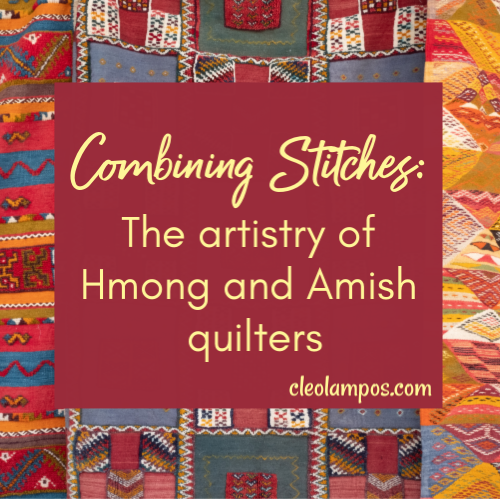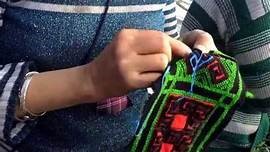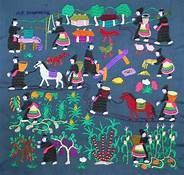Cleo Thoughts, Quilts
Combining Stitches: The artistry of Hmong and Amish quilters
“Instead of putting others in their place, put yourself in their place.” -Amish Proverb

The hours of inactivity in the Thai refugee camp deadened the spirit and the soul. So the Hmong women turned to the comfort that needle and thread had given to generations of women before them. As their sharp needles slid through cloth at the rate of 8 stitches per inch, the refugees softened the bright colors they craved in order to please the westerners who purchased their hand sewn crafts. Potholders, eyeglass cases, purses, wall hangings, pillow covers and aprons sold well, supplying a meager income in a desperate setting.

“A tiny needle, strands of bridge thread, lengths of vari-coloured cloth, and the genius of a Hmong woman – these are the ingredients of some of the most exquisite needlework to be found anywhere. Throughout their long history, Hmong women have devoted their artistic skill and industry to the development of an amazing variety of techniques using needle and thread…”1
The most valued form of Hmong needle art to emerge from the refugee camps are the story cloths. These colorful pictorial embroideries related the Hmong history. The men drew on the fabric, then the women stitched the stories of daily life, and the escape of their families after the Vietnam War to Thailand’s camps. The Americans realized the value of these story cloths and cherished them.

“For the entire law is fulfilled in keeping this one command: ‘Love your neighbor as yourself.’” Galatians 5:14.
The Mennonite Central Committee sponsored groups of Hmong refugees in the late 1970’s. These brave folk from the mountainous regions of Laos, Thailand and Vietnam had supported American troops during the Vietnam War, and now needed to leave their simple, close-knit traditional lives for the safety of emigration to the United States. The transition for the women was especially difficult, because education was sparse in the mountain areas, and usually available only to males. Fine needlework defined the Hmong women and they took great pride in the bright colored embellishments appliqued in ultra-fine stitching. “In Laos, sewing skills reflected a Hmong woman’s wealth and abilities, and therefore girls endeavored to perfect intricate, visually stimulating designs,” reports historian Heather Gibson.
Mennonite and Amish crafters of Pennsylvania noticed.
The Pennsylvania Amish sew-ers observed the extraordinary ability of the Hmong women to consistently produce tiny-stitched applique of complicated designs. Soon, a cottage industry was created for the home-loving Hmong. Within the confines and safety of their family, the Hmong women busily finished Amish quilts. Piece work in the literal sense of the word. However, the natural creativity of these refugee stitchers was not embraced within the strict limits of traditional Amish quilt making.

Typical Amish quiltwork from coloursandfabricsblogspot.com
Emma Witmer noticed.
Old Order Mennonite businesswoman Emma Witmer has combined the unique styles of Amish, Mennonite and Hmong needleworkers. Since the 1990’s Witmet has designed and sold hybrid quilts featuring Hmong paj ntaub (flower cloth). This has been a “win-win” for all of the quilters who love to express themselves and their cultures through fabrics.

Photo from World Quilts, circa 1980 Hmong patchwork
The amazing beauty of their work is testament to the fact that there are no bounds in quilting that friendship and love cannot overcome with the common goal of creating comforting masterpieces. The stunning results produced by these divergent women appeals to the market as well as the makers. Piecing echoes the conservative Mennonite community’s dedication to simplicity. Applique reflects the intricate fancy stitches of the talented Hmong. Blending the traditions and cultures into Hmong-Amish comforters, Emma Witmer has advanced quilt making in this century.

unsplash.com
By reaching out to refugees. By showing empathy to strangers from across the sea. By realizing the unique skills that others display. By standing in the sandals another person, two cultures are now pieced together in the warmth of friendship and quilts.

“For I was hungry and you gave me food, I was thirsty and you gave me drink, I was a stranger and you welcomed me.” Matthew 25:3

Welshquilts.blogspot.com Hmong influenced quilt
Footnotes:1. Paul and Elaine Lewis, Peoples of the Golden Triangle
Photo credits: https://unsplash.com/photos/z4x9ITBe040, https://unsplash.com/photos/icrgOVY8p10
